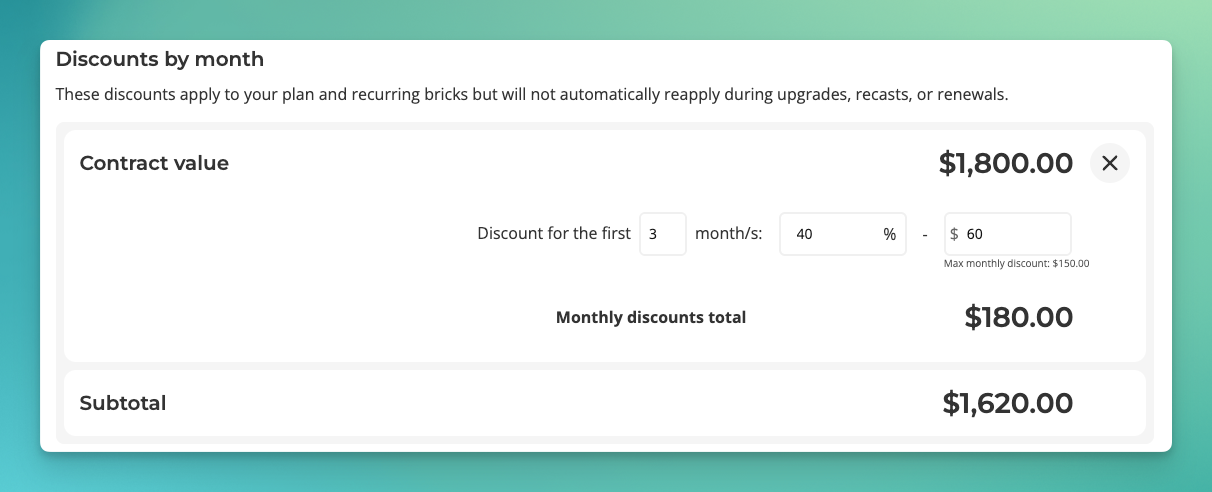Overview
Duration discounts provide an alternative deal shaping approach to line item discounts. This method involves applying an upfront discount for a portion of the contract term. These discounts are calculated based on the order’s total contract value (TCV) and apply to subscription-based (recurring) bricks.
Setup
1. Create an order and select a product, plan, and bricks. 2. Under the “Discounts and billing” section, click “Add/Edit discount.” 3. Use the “Discounts by month” section to add a duration discount to the order.How duration discounts work
- Contract-level discounts: Duration discounts are applied to the TCV, rather than individual line items.
- Recurring bricks only: Duration discounts apply to recurring charges (plan and/or subscription-based bricks), but excludes non-recurring charges such as usage and bricks charged one-time upfront.
- One-time discounts: Duration discounts are one-time discounts, and do not carry over into subsequent agreements.
- Example 1: You close a 15-month initial contract with automatic renewal terms, and a 50% discount for the first 3 months.
This order would autorenew as another 15-month contract (having inherited the original contract length). However, the duration discount from the initial deal would not apply to the renewal. - Example 2: You close a 7-month initial contract with automatic renewal terms, and a 100% discount for all 7 months.
This order would autorenew as another 7-month contract with no duration discount applied.
- Example 1: You close a 15-month initial contract with automatic renewal terms, and a 50% discount for the first 3 months.
Formula
Discount (in dollars) = grand total of subscription bricks × (n ÷ total contract months) × (r ÷ 100)
- n = number of months the discount applies
- r = discount rate
- Grand total of subscription bricks: $1,000
- Total contract months: 12 months
- Number of discounted months (n): 6 months
- Discount rate (r): 10%
- Discount amount = $1,000 × (6 ÷ 12) × (10 ÷ 100) = $50
Use case 1
In this example, we apply duration discounts to a contract with a quarterly billing schedule. Order details:| TCV | $1200 |
| Duration discount | 50% off the first 5 months |
| Total duration discount (Per month × rate × duration) | $250 |
| Expected revenue (TCV - discounts) | $950 |
| Grand total | Total months discounted | Total period discount | Expected bill | |
|---|---|---|---|---|
| Q1 | $300 | 3 | $150 | $150 |
| Q2 | $300 | 2 | $100 | $200 |
| Q3 | $300 | 0 | 0 | $300 |
| Q4 | $300 | 0 | 0 | $300 |
| Total expected bill | $950 | |||
| Total discounted months | 5 |
| TCV | $1200 |
| Discount per line item | 10% sales rate = $120 |
| Adjusted TCV | $1080 |
| Discount by duration | 50% off the adjusted TCV for the first 5 months = $225 |
| Expected revenue | $855 |
| Grand total (after line item discounts) | Total months discounted | Total period discount | Expected bill | |
|---|---|---|---|---|
| Q1 | $270 | 3 | $135 | $135 |
| Q2 | $270 | 2 | $90 | $180 |
| Q3 | $270 | 0 | 0 | $270 |
| Q4 | $270 | 0 | 0 | $270 |
| Total expected bill | $855 | |||
| Total discounted months | 5 |
Use case 2
If you upsell a deal with duration discounts before the end of the discounted period, the duration discounts would not apply to the co-termed upgrade, but will continue to apply to the base deal. Initial order details:| Start date | Jan 1 2024 - Jan 1 2025 |
| TCV | $1200 |
| Discount by duration | 50% off the first 5 months = $250 or $50 per month |
| Expected revenue | $950 |
| Start date | Feb 1 2024 - Jan 1 2025 |
| TCV | $1100 |
| Jan - March | Apr - June | Jul - Sep | Oct - Dec | |
|---|---|---|---|---|
| Initial order | $150 | $200 | $300 | $300 |
| Upgrade order | $200 (prorated for Feb & March) | $300 | $300 | $300 |
| Combined expected bill | $350 | $500 | $600 | $600 |